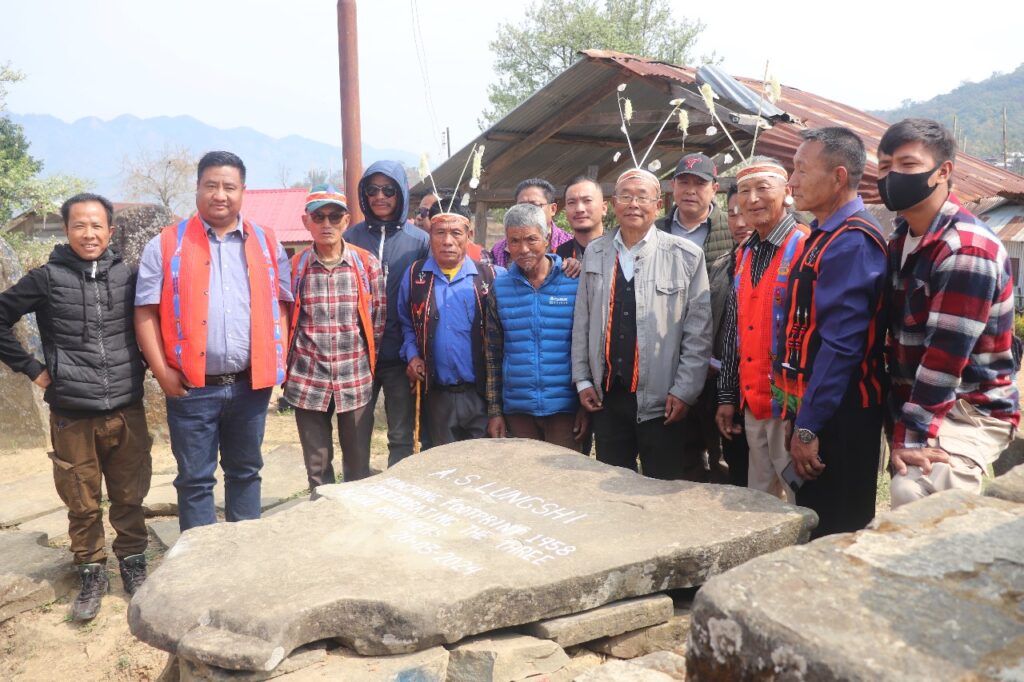EKHON | UKHRUL: Late AS Lungshi, a royal from Hungpung village, whose footprint was carved in an ancient stone of Khongdei village in Senapati district in 1958 was officially unveiled following the traditional blood sacrifice of a cow and observing the traditional custom of no physical activities by the village folks to commemorate and reaffirm the blood relation between three brothers; Khongdei, Hungpung and Meitei at Khongdei, Senapati district of Manipur. NK Ninghor, Chief of Khongdei village unveiled the stone monolith in the presence of Khongdei village council and sons and grandsons of late AS Lungshi at the ancestral ground of the village.
While unveiling the monolith, NK Ninghor, village chief said the stone slab is not an ordinary stone but preserved as sacred since the beginning of time by their forefathers and women are forbidden to touch or sit on it and no one can scribble on it. It is only because he is blood related that Khongdei allowed AS Lungshi to engrave his footprint on the ancient stone and today we let the family engrave his name on it for the same reason, informed NK Ninghor. He also added that this engraving is not for any mere friends adding that this sacred event reaffirmed their ancient narrative of blood relation between the three brothers, namely Khongdei, Hungpung and Meitei.

Sharing the backdrop of the history, NK Ninghor narrated the story of how a woman became pregnant after a butterfly came and sat on her breast and birthed three sons who were named Riso (Khongrei), Hiipam (Hungpung) and Meja (Meitei). Later, Hiipam and Meja migrated to their present places in Hungpung and Imphal valley respectively. Remains of the ancient stone indicated that 12 generations of Tangkhul (Hungpung) has migrated from Khongdei over centuries. Whereabouts of the migration is vague but insisted that they are not just in Hungpung but spread across the place, NK Ninghor further added.
The interaction regarding the blood relation has been ongoing for the last six years but nothing concrete has happened so far until today, remarked NK Ninghor adding that this interaction and dialogue should continue between the brothers and further suggested that they should invite each other in the cultural festivals and have more cultural exchange programs going forward.


AS Boniface Hungshi, a lecturer by profession and one of the grandsons of late AS Lungshi, who is instrumental in initiating this historic event narrated the events that led to this day.
When i first came to this village in 2018, we were told by the then Chief Uphei that the nameless footprint belonged to one AS Lungshi from Hungpung. When asked why there is no name, he answered that at that point of time there were no skilled person to engrave the name but we were told that it belonged to Lungshi. The first question we asked was, why do they keep the footprint of Lungshi? They answered that it is because we are blood brothers.”


However, he was compelled to cross examined the reason by asking, “if your close friend come and visit, do you keep their footprint? the Chief replied, No, we don’t. Unless it of the same blood we cannot engraved their footprint in our sacred stone. This response gave me a lot to think about.” From that moment, AS Boniface Hungshi said he realized that there is a very important treasure in this place and that they have to engrave the name by all means. And that’s how today we came to fulfil this desire.” stated Boniface Hungshi.
He also shared a brief on his grandfather who was known for his witty personality and an ardent traveller. It was said that late AS Lungshi was a multifaceted person who also took the role of the chief of Hungpung on behalf of Awo Rulo, the then Chief of Hungpung in observing justice and acting as a diplomat with the erstwhile Meitei kingdom. Coming from an affluent background and adventurous by nature, he led a colorful life and travelled extensively in a horseback.


Boniface Hungshi also expressed his joy at the warm reception accorded by the Khongdei village community and asserted his commitment to continue the brotherly bond.
Later, the visitors from Hungpung were taken on a tour to various location that has cultural and historical relevance. Despite conversion to Christianity, the village continued to observe and follow certain cultural tradition. The village settlement is marked by remnants of ancient civilization dating back thousands of years. They live among ancient ruins and ancient stones that has remarkable stories. Some of the remains that are worth mentioning are the Meithalung, the three stone fires where the last meal was supposedly cooked by the three brothers before they depart to their new settlement, the hollow stone that was used to gather heads hunted during wars, the stone that has marks of spear indicating the numbers of migration, footprints of different animals among many others.
(The writer can be reached at Jenny.thingshung@gmail.com)
